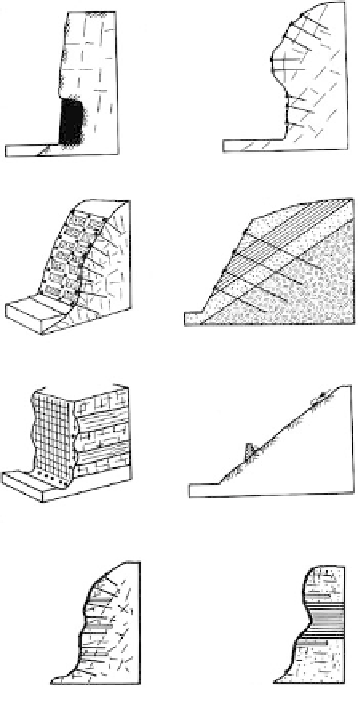Environmental Engineering Reference
In-Depth Information
(a)
(b)
(c)
(d)
(e)
(f)
FIGURE 9.113
Various methods of retaining hard rock slopes: (a) concrete
pedestals for overhangs; (b) rock bolts for jointed masses; (c)
bolts and concrete straps for intensely jointed masses: (d)
cable anchors to increase support depth; (e) wire mesh to
constrain falls; (f) impact walls to deflect or contain rolling
blocks; (g) shotcrete to reinforce loose rock, with bolts and
drains; (h) shotcrete to retard weathering and slaking of
shales.
(g)
(h)
with more resistant rocks (see
Figure 6.48).
Shotcrete is normally used with wire
mesh and dowels, bolts or nails as discussed below.
Gunite is similar to shotcrete except that the aggregate is smaller.
●
Reinforcing Rock Slopes
Rock anchors
are tensile units, fixed at one end, used to place large blocks in compression,
and should be installed as near to perpendicular to a joint as practical. The ordinary types
consist of rods installed in drill holes either by driving and wedging, driving and expand-
ing, or by grouting with mortar or resins as illustrated in
Figure 9.118
.
Bolt heads are then
attached to the rod and torqued against a metal plate to impose the compressive force on
the mass. Weathering of rock around the bolt head may cause a loss in tension; therefore,
heads are usually protected with concrete or other means, or used in conjunction with con-
crete straps in high-risk conditions.
Fully grouted rock bolts
, illustrated in
Figure 9.119,
provide a more permanent anchor
than those shown in Figure 9.118. The ordinary anchor is subject to loss in tension with
time from several possible sources including corrosion from attack by aggressive water,
anchorage slip or rock spalling around and under the bearing plate, and block movement
along joints pinching the shaft. Care is required during grouting to minimize grout spread,
which results in decreasing mass drainage, especially where bolts are closely spaced.
Drain holes may be required.



